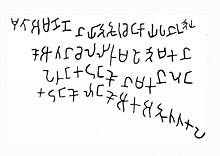Perum Cheral Irumporai
| Perum Cheral Irumporai | |
|---|---|
| Thagadur Erinta | |
 Pugalur inscription | |
| Issue | Ilam Cheral Irumporai |
| House | Chera |
| Father | Chelva Kadumgo Vazhi Athan |

Perum Cheral Irumporai, known as Perum Kadungon, was a member of the Irumporai line of the Chera dynasty in early historic south India (c. 1st - 4th century CE).[1][2] He is the hero of the eighth chapter of the Pathitruppathu composed by poet Arichil Kizhar.[3] He is also addressed as "Kothai Marpa" in the Tamil songs.[4]
He probably was a member of the Irumporai/Porai line, a collateral branch of the Chera family (dominating the Kongu country with Karuvur/Karur as their headquarters). Chelva Kadungo Vazhi Athan, father of Perum Cheral, was praised for his possession of Kodumanam (present-day Kodumanal) and Pandar (Koyilandy?) on the Malabar Coast.[5]
He is famous for the victory over Thagadur Adiyaman chieftain Ezhini.[3][4] He also seems to have defeated a minor Idayar chief called Kazhuval or Kazhuvul [4][5] He is praised as the overlord of Pukar, the Chola capital, the Kolli hills and Puzhi Nadu region.[4][5]
Perum Cheral is sometimes identified with Perum Kadungon, the Irumporai Chera royal mentioned in the two near-identical Pugalur inscriptions.[1][6] The inscriptions record the construction of a rock shelter for Chenkayapan, a Jain monk on the occasion of the inauguration of Kadungon Ilam Kadungo, son of Perum Kadungon, the son of king Athan Chel Irumporai/Irumpurai as the heir apparent ("Ilamgo").[2] The three Chera royals can be identified with Chelva Kadungo Vazhi Athan, Perum Cheral Irumporai and Ilam Cheral Irumporai mentioned in the early Tamil literature (decades 7-9, Pathitruppathu Collection).[2]
References
[edit]- ^ a b Pletcher, Kenneth, ed. (2024). "Cera dynasty". Encyclopædia Britannica.
- ^ a b c Mahadevan, Iravatham (2003). Early Tamil Epigraphy: From the Earliest Times to the Sixth Centuy AD. Harvard Oriental Series. Cre-A and Harvard University. pp. 117–119.
- ^ a b Zvelebil, Kamil (1973). The Smile of Murugan: On Tamil Literature of South India. Leiden: E. J. Brill. pp. 40 and 52-53.
- ^ a b c d Aiyar, K. G. Sesha (1937). Chera Kings of the Sangam Period. London: Luzac and Co. pp. 41–43.
- ^ a b c Subbarayalu, Y. (2014). "Early Tamil Polity". In Karashima, Noburu (ed.). A Concise History of South India: Issues and Interpretations. New Delhi: Oxford University Press. pp. 49–50.
- ^ Champakalakshmi, R. (2003). "A magnum opus on Tamil-Brahmi inscriptions". Frontline Magazine.
